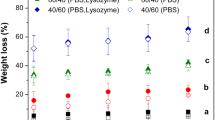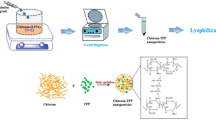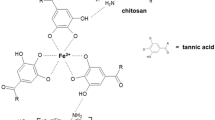Abstract
The optically transparent biocompatible, biodegradable, wound-healing materials were obtained based on chitosan and poly(lactide–titanium oxide). The optical transmittance of these films was more than 70% in the visible light region. The decreasing of the films transmittance by ~ 5–10% was observed under its UV irradiation as a result of the one-electron transition Ti4+ + e− ⇄ Ti3+. The tensile strength of the samples was up to 117 MPa. The investigation of the materials biocompatibility on experimental animals demonstrated the positive blood parameters and the absence of the inflammation process in the animals’ organisms, allergic reactions and stress after implantation of film and non-toxicity of the composite. The materials can be bioutilized and are biodegradable. The fibroblast cells (hTERT BY-5ta) adhesion and proliferation on the films surface were demonstrated in vitro. The films exhibited the UV-induced antibacterial properties.
Graphic abstract







Similar content being viewed by others
References
Peden M, Oyegbite K, Ozanne-Smith J et al (2008) World report on child injury prevention. World Health Organization, Switzerland
Sheikh Z, Najeeb Sh, Khurshid Z, Verma V, Rashid H, Glogauer M (2015) Biodegradable materials for bone repair and tissue engineering applications. Materials 8:5744–5794. https://doi.org/10.3390/ma8095273
Roslan AN (2013) Biodegradable films from poly (lactic acid) (PLA)-chitosan-polyethylene glycol (PEG): fabrication and evaluation of mechanical properties. UMP, Kuantan, Pahang
Toncheva A, Spasova M, Paneva D, Manolova N, Rashkov I (2014) Polylactide (PLA)-based electrospun fibrous materials containing ionic drugs as wound dressing materials: a review. Int J Polym Mater Polym Biomater 63(13):657–671. https://doi.org/10.1080/00914037.2013.854240
Pihlajamaki HK, Salminen ST, Tynninen O, Bostman OM, Laitinen O (2010) Tissue restoration after implantation of polyglycolide, polydioxanone, polylevolactide, and metallic pins in cortical bone: an experimental study in rabbits. Calcif Tissue Int 87:90–98. https://doi.org/10.1007/s00223-010-9374-z
Archana D, Singh BK, Dutta J, Dutta PK (2013) In vivo evaluation of chitosan–PVP–titanium dioxide nanocomposites as wound dressing material. Carbohydr Polym 95:530–539. https://doi.org/10.1016/j.carbpol.2013.03.034
Poonguzhali R, Basha SK, Kumari VS (2017) Synthesis and characterization of chitosan-PVP-nanocellulose composites for in vitro wound dressing application. Int J Biol Macromol 105:111–120. https://doi.org/10.1016/j.ijbiomac.2017.07.006
Stagnaro P, Schizzi I, Utzeri R, Marsano E, Castellano M (2018) Alginate-polymethacrylate hybrid hydrogels for potential osteochondral tissue regeneration. Carbohydr Polym 185:56–62. https://doi.org/10.1016/j.carbpol.2018.01.012
Kailani MH, Jafar H, Awidi A (2016) Synthetic biomaterials for skin tissue engineering. In: Albanna MZ, James H (eds) Skin tissue engineering and regenerative medicine. Academic Press, London, pp 163–183
Chena Q, Bruyneel A, Carr C, Czernuszka J (2013) Bio-mechanical properties of novel bi-layer collagen-elastin scaffolds for heart valve tissue engineering. Procedia Eng 59:247–254. https://doi.org/10.1016/j.proeng.2013.05.118
Barenghi R, Beke S, Romano I, Gavazzo P, Vassalli Farkas B, Brandi F, Scaglione S (2014) Elastin-coated biodegradable photopolymer scaffolds for tissue engineering applications. Biomed Res Int. https://doi.org/10.1155/2014/624645
León-Mancilla BH, Araiza-Téllez MA, Flores-Flores JO, Pina-Barba MC (2016) Physico-chemical characterization of collagen scaffolds for tissue engineering. J Appl Res Technol 14:77–85. https://doi.org/10.1016/j.jart.2016.01.001
Fan X, Chen C, Hea X, Li N, Huanga J, Tang K, Li Y, Wang F (2016) Nano-TiO2/collagen-chitosan porous scaffold for wound repairing. Int J Biol Macromol 91:15–22. https://doi.org/10.1016/j.ijbiomac.2016.05.094
Bitar KN, Raghavan S, Zakhem E (2014) Tissue engineering in the gut: developments in neuro musculature. Gastroenterology 146(7):1614–1624. https://doi.org/10.1053/j.gastro.2014.03.044
Karimi A, Navidbakhsh M, Faghihi S (2014) Fabrication and mechanical characterization of a polyvinyl alcohol sponge for tissue engineering applications. Perfusion 29(3):231–237. https://doi.org/10.1177/0267659113513823
Kim J, Lee CM (2017) Wound healing potential of a polyvinyl alcohol-blended pectin hydrogel containing Hippophae rahmnoides L. extract in a rat model. Int J Biol Macromol 99:586–593. https://doi.org/10.1016/j.ijbiomac.2017.03.014
Golafshan N, Rezahasani R, Esfahani TM, Kharaziha M, Khorasani SN (2017) Nanohybrid hydrogels of laponite: PVA-alginate as a potential wound healing material. Carbohydr Polym 176(15):392–401
Venkatesan J, Bhatnagar I, Manivasagan P, Kanga KH, Kim SK (2015) Alginate composites for bone tissue engineering: a review. Int J Biol Macromol 72:269–281. https://doi.org/10.1016/j.carbpol.2017.08.070
Hancı D, Altun H (2015) Effectiveness of hyaluronic acid in post-tonsillectomy pain relief and wound healing: a prospective, double-blind, controlled clinical study. Int J Pediatric Otorhinol 79(9):1388–1392. https://doi.org/10.1016/j.ijporl.2015.07.016
Dahlgren LA, Milton SC, Boswell SG, Werre SR, Brewster CC, Jones CS, Crisman MK (2016) Evaluation of a hyaluronic acid-based biomaterial to enhance wound healing in the equine distal limb. J Equine Vet Sci 44:90–99. https://doi.org/10.1016/j.jevs.2016.05.011
Dai T, Tanaka M, Huang Y-Y, Hamblin MR (2011) Chitosan preparations for wounds and burns: antimicrobial and wound-healing effects. Expert Rev Anti Infect Ther 9(7):857–879. https://doi.org/10.1586/eri.11.59
Ahmed Sh, Ali AA, Sheikh J (2018) A review on chitosan centred scaffolds and their applications in tissue engineering. Int J Biol Macromol 116:849–862. https://doi.org/10.1016/j.ijbiomac.2018.04.176
Samadi S, Moradkhani M, Beheshti B, Irani M (2018) Aliabadi M (2018) Fabrication of chitosan/poly(lactic acid)/grapheme oxide/TiO2 composite nanofibrous scaffolds for sustained delivery of doxorubicin and treatment of lung cancer. Int J Biol Macromol 110:416–424. https://doi.org/10.1016/j.ijbiomac.2017.08.048
Balagangadharan K, Dhivya S (2017) Selvamurugan N (2017) Chitosan based nanofibers in bone tissue engineering. Int J Bio Macromol 104:1372–1382. https://doi.org/10.1016/j.ijbiomac.2016.12.046
Jennings JA, Bumgardner JD (2017) Chitosan based biomaterials: fundamentals, vol 1. Woodhead Publishing, Cambridge. https://doi.org/10.1016/C2014-0-03147-4
Miguel SP, Moreira AF, Correia IJ (2019) Chitosan based-asymmetric membranes for wound healing: a review. Int J Biol Macromol 127:460–475. https://doi.org/10.1016/j.ijbiomac.2019.01.072
Biranje SS, Madiwale PV, Patankar KC, Chhabra R, Dandekar-Jain P, Adivarekar RV (2019) Hemostasis and anti-necrotic activity of wound-healing dressing containing chitosan nanoparticles. Int J Biol Macromol 121:936–946. https://doi.org/10.1016/j.ijbiomac.2018.10.125
Liu X, Niu Y, Chen KC, Chen Sh (2017) Rapid hemostatic and mild polyurethane-urea foam wound dressing for promoting wound healing. Mat Sci Eng C 71:289–297. https://doi.org/10.1016/j.msec.2016.10.019
Lee SM, Park IK, Kim YS, Kim HJ, Moon H, Mueller S, Jeong Y-I (2016) Physical, morphological, and wound healing properties of a polyurethane foam-film dressing. Biomater Res 20:15–26. https://doi.org/10.1186/s40824-016-0063-5
Rinaudo M (2006) Chitin and chitosan: properties and applications. Prog Polym Sci 31:603–632. https://doi.org/10.1016/j.progpolymsci.2006.06.001
Chang SH, Lin HT, Wu GJ, Tsai GJ (2015) pH Effects on solubility, zeta potential, and correlation between antibacterial activity and molecular weight of chitosan. Carbohydr Polym 134:74–81. https://doi.org/10.1016/j.carbpol.2015.07.072
Kim S-E (2010) Chitin, chitosan, oligosaccharides and their derivatives: biological activities and applications, 1st edn. CRC Press, London
Muzzarelli RAA (2009) Chitins and chitosans for the repair of wounded skin, nerve, cartilage and bone. Carbohydr Polym 76:167–182. https://doi.org/10.1016/j.carbpol.2008.11.002
Smith AM, Moxon S, Morris GA (2016) Biopolymers as wound healing materials. Wound Healing Biomater 2:261–287. https://doi.org/10.1016/b978-1-78242-456-7.00013-1
Farah S, Anderson DG, Langer R (2016) Physical and mechanical properties of PLA, and their functions in widespread applications—a comprehensive review. Adv Drug Deliv Rev 107:367–392. https://doi.org/10.1016/j.addr.2016.06.012
Kean T, Thanou M (2010) Biodegradation, biodistribution and toxicity of chitosan. Adv Drug Deliv Rev 62(1):3–11. https://doi.org/10.1016/j.addr.2009.09.004
Park SY, Park HJ, Lin XQ, Sano Y (2000) Characterization of chitosan film and structure in solution. Hydrocolloids 1:199–204. https://doi.org/10.1016/B978-044450178-3/50024-X
Pippi P (2017) Post-surgical clinical monitoring of soft tissue wound healing in periodontal and implant surgery. Int J Med Sci 14(8):721–728. https://doi.org/10.7150/ijms.19727
Smith JK, Bumgardner JD, Courtney HS, Smeltzer MS, Haggard WO (2010) J Biomed Mater Res B Appl Biomater 94(1):203–211. https://doi.org/10.1002/jbm.b.31642
Guo S, DiPietro LA (2010) Factors affecting wound healing. J Dent Res 89(3):219–229. https://doi.org/10.1177/0022034509359125
Fujishima A, Zhang X, Tryk D (2007) Heterogeneous photocatalysis: from water photolysis to applications in environmental clean up. Int J Hydrog Energy 14:2664–2672. https://doi.org/10.1016/j.ijhydene.2006.09.009
Behera SS, Das U, Kumar A, Bissoyi A, Singh AK (2017) Chitosan/TiO2 composite membrane improves proliferation and survival of L929 fibroblast cells: application in wound dressing and skin regeneration. Int J Biol Macromol 98:329–340. https://doi.org/10.1016/j.ijbiomac.2017.02.017
Srikanth B, Goutham R, Narayan RB, Ramprasath A, Gopinath KP, Sankaranarayanan AR (2017) Recent advancements in supporting materials for immobilised photocatalytic applications in waste water treatment. J Environ Manag 200:60–78. https://doi.org/10.1016/j.jenvman.2017.05.063
Fujishima A, Rao TN, Tryk DA (2000) Titanium dioxide photocatalysis. J Photochem Photobiol C Photochem Rev 1:1–21
Ahmed AY, Kandiel TA, Oekermann T (2011) Photocatalytic activities of different well-defined crystal TiO2 surfaces: anatase versus rutile. J Phys Chem Lett 2:2461–2465. https://doi.org/10.1021/jz201156b
Volchegorskii IA, Nalimov AG, Iarovinskii BG, Lifshits RI (1989) Comparison of various approaches to the determination of the products of lipid peroxidation in heptane-isopropanol extracts of blood. Vopr Med Khim 35:127–131
Lvovskaya EI, Volchegorsky IA, Shemyarov SE (1991) Spectrophometric estimation of the final lipoperoxidation products. Vopr Med Chem 4:92–93 (In Russian, English abstract)
Glantz SA (2012) Primer of biostatistics, Seven edn. McGraw-Hill, New York, p 327
Liu Zh-T, Li Ch-Y, Chen J-D, Liu W-L, Tsai Ch-Y, Ko B-T (2017) Titanium, aluminum and zinc complexes containing diamine-bis(benzotriazole phenolate) ligands: synthesis, structural characterization and catalytic studies for ring-opening polymerization of ε-caprolactone. J Mol Struct 1134:395–403. https://doi.org/10.1016/j.molstruc.2016.12.081
Cheshmedzhieva D, Angelova I, Ilieva S, Georgiev GS, Galabov B (2012) Initiation of ring-opening polymerization of lactide: the effect of metal alkoxide catalyst. Comput Theor Chem 995:8–16. https://doi.org/10.1016/j.comptc.2012.06.015
Li W, Zhang Ch, Chi H, Li L, Lan T, Han P, Chen H, Qin Y (2017) Development of antimicrobial packaging film made from poly(lactic acid) incorporating titanium dioxide and silver nanoparticles. Molecules 22(7):1170–1185. https://doi.org/10.3390/molecules22071170
Kim Y, Verkade JG (2005) Living polymerization of lactide using titanium alkoxide catalysts. Macromol Symp 224(1):105–118. https://doi.org/10.1002/masy.200550610
Salomatina EV, Bityurin NM, Gulenova MV et al (2013) Synthesis, structure, and properties of organic–inorganic nanocomposites containing poly(titanium oxide). J Mater Chem C 39(1):6375–6385. https://doi.org/10.1039/c3tc30432a
Liao H-T, Wu Ch-S (2008) New biodegradable blends prepared from polylactide, titanium tetraisopropylate, and starch. J App Polym Sci 108(4):2280–2289. https://doi.org/10.1002/app.27901
Chiang PC, Whang WT (2003) The synthesis and morphology characteristic study of BAO-ODPA polyimide/TiO2 nano hybrid films. Polymer 44:2249–2254. https://doi.org/10.1016/S0032-3861(03)00086-7
Shao PL, Mauritz KA, Moore RB (1996) Perfluorosulfonate ionomer]/[SiO2-TiO2] nanocomposites via polymer in situ sol-gel chemistry: sequential alkoxide procedure. J Polym Sci Part B Polym Phys 34:873–882. https://doi.org/10.1002/(SICI)1099-0488(19960415)34:5%3c873:AID-POLB6%3e3.0.CO;2-N
Gallagher AJ, Anniadh AN, Bruyere K, Otténio M, Xie H, Gilchrist MD (2012) Dynamic tensile properties of human skin. In: IRCOBI conference IRC-12-59, pp 494–502
Joodaki H, Panzer MB (2018) Skin mechanical properties and modeling: a review. Proc Inst Mech Eng [H] 232(4):323–343. https://doi.org/10.1177/0954411918759801
Bain BJ (2008) Blood cells: a practical guide, 4th edn. Wiley-Blackwell, Willey
Shurygina IA, Shurygin MG, Ayushinova NI, Kanya OV (2012) Fibroblasts and their role in the development of connective tissue. Sib Med J (Irkutsk) 3:8–12
Howling GI, Dettmar PW, Goddard PA, Hampson FC, Dornish M, Wood EJ (2001) The effect of chitin and chitosan on the proliferation of human skin fibroblasts and keratinocytes in vitro. Biomaterials 22:2959–2966. https://doi.org/10.1016/S0142-9612(01)00042-4
Acknowledgements
This work was carried out with financial supporting of the Ministry of Education and Science of the Russian Federation (Contract No. 4.3760.2017/PCh).
Author information
Authors and Affiliations
Corresponding author
Additional information
Publisher's Note
Springer Nature remains neutral with regard to jurisdictional claims in published maps and institutional affiliations.
Rights and permissions
About this article
Cite this article
Salomatina, E.V., Lednev, I.R., Silina, N.E. et al. Biocompatible compositions based on chitosan and copolymer (lactide–titanium oxide) for engineering of tissue substitutes for wound healing. Polym. Bull. 77, 5083–5101 (2020). https://doi.org/10.1007/s00289-019-03007-3
Received:
Revised:
Accepted:
Published:
Issue Date:
DOI: https://doi.org/10.1007/s00289-019-03007-3




